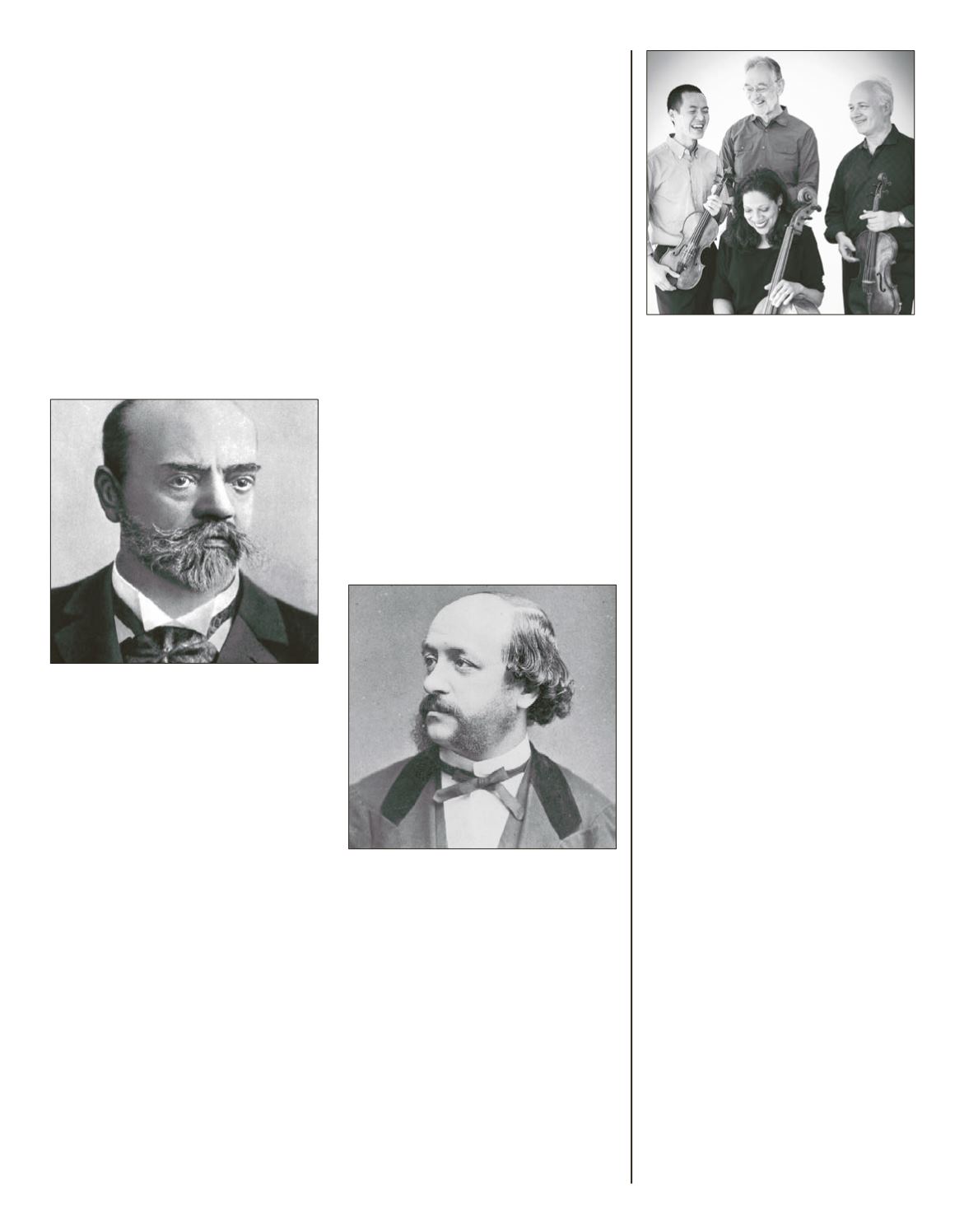

$N7ONN D9OĎ. (1841–1904)
String Quartet No. in C major, .
In May
, Dvořák plunged headlong into the
composition of
Dimitrij,
a four-act grand opera
for Prague’s new National
eater.
ough the
premiere stood more than months in the fu-
ture, the composer required every last moment
to complete the score. Early in the opera’s evo-
lution, though, he received a startling reminder
of another project from Joseph Hellmesberger.
is renowned violinist—a professor at the Vi-
enna Conservatory and concertmaster of the
imperial court orchestra—had met Dvořák
some months earlier through Johannes Brahms
and was deeply impressed by a performance of
his String Sextet in A major, .
, and String
Quartet No.
in E- at major, .
. Hellmes-
berger immediately requested a new work for
his own string quartet.
Absorbed in the opera, Dvořák had utterly for-
gotten about the quartet commission. He made
several failed attempts at a piece in F major be-
tween October and . However, when Hellmes-
berger announced the impending quartet pre-
miere, Dvořák could delay no longer and began
a C-major quartet in earnest. He explained to his
friend Alois Göbl on November , “I read in the
newspaper that on December , Hellmesberg-
er will play my new quartet, which still doesn’t
exist! What could I do but leave the opera and
write the quartet. I already have three move-
ments prepared and am working on the nale.”
Dvořák completed the score during a remark-
ably compact -day period (October – No-
vember ). In the end, his rush proved a point-
less exercise, for the Hellmesberger Quartet did
not give the world premiere until November
the following year in Berlin.
ough less well known than some of Dvořák’s
other chamber music, the Quartet No. in C
major, .
, is a nely cra ed work. Several
authors attribute its relative unfamiliarity to
the comparative absence of Czech style traits.
John Clapham has suggested that the composer
suppressed this nationalist element “because he
was aware that a part of the Viennese public har-
bored prejudices against the Czechs.” Instead,
Dvořák conceived a gorgeous, “pure” piece of
chamber music conveying a Classical sense of
balance, proportion, and unity.
e
Allegro
begins with an extended increase
in volume and expressive intensity as the rst
violin unfurls its theme (the melody, perhaps
unintentionally, echoes Handel’s theme from
Judas Maccabaeus
known presently as the hymn
“ ine Is the Glory”). e instruments trade o
brief motivic ideas and fragments of the open-
ing theme while making a transition to another
gentle, syncopated rst-violin theme. Dvořák
elaborates on phrases from the opening melo-
dy in the development, and then he restates the
main themes in slightly varied order.
Novelties of texture partly account for the slow
movement’s captivating e ect. Dvořák had orig-
inally intended this musical material for his Vi-
olin Sonata in F major, .
. Violins converse
in the spirit of an operatic duet while the lower
strings intertwine in a broad, arching accompa-
niment. e second violin o ers another expres-
sive theme, centrally placed in the movement.
(Its initial rhythm recalls the
Allegro
’s opening
melody.) Eventually the violins resume their
“duet.”
Dvořák derived the
Scherzo
theme from his Po-
lonaise for Cello and Piano in A major, .
.
Its melody and rhythm also mirror the quar-
tet’s rst movement. One of the few conspicu-
ous re ections of Czech music occurs with the
trio
’s folk melody and drone accompaniment.
e nationalistic element emerges more openly
in the spirited
Finale
, whose principal melody
also comes from the cello polonaise. Dvořák
generates considerable excitement at the end
by changing tempo, shi ing between dynamic
extremes, and nally growing louder and accel-
erating toward two climactic chords.
–Program notes © Todd E. Sullivan
JUILLIARD STRING QUARTET
e Juilliard String Quartet was created in
as the quartet-in-residence of its namesake, e
Juilliard School.
roughout its history the en-
semble’s credo has been to “play new works as if
they were established masterpieces, and estab-
lished masterpieces as if they were new”; the JSQ
has performed more than
works, including
the premieres of more than pieces by Ameri-
can composers. In recent seasons the quartet has
performed at such venues as the Vienna Konzer-
thaus, Bonn’s Beethoven Festival, Madrid’s Pala-
cio Real, Paris’s Cité de la musique, Tokyo’s Kioi
Hall, London’s Wigmore Hall and Queen Eliz-
abeth Hall, the Moscow International Perform-
ing Arts Center, Australia’s Musica Viva Cham-
ber Music Festival, Carnegie Hall, the Kennedy
Center, and San Francisco’s Herbst
eatre. In
the JSQ was the subject of the lm
Keep-
ing Beethoven Contemporary
, which showed the
quartet rehearsing and performing Beethoven’s
op.
quartet with the original
Grosse Fuge
,
and in
it created an app o ering an interac-
tive experience with Schubert’s “Death and the
Maiden” Quartet. rough its annual seminar at
Juilliard, the ensemble has worked with numer-
ous graduate quartets-in-residence and has been
instrumental in forming other string quartets,
including the A ara, Alexander, Emerson, La
Salle, and Shanghai. Among the JSQ’s over
recordings to date are four Grammy-winning al-
bums, including the complete quartets of Bartók
and Schoenberg, quartets by Debussy and Ravel,
and Beethoven’s late quartets.
e quartet was
inducted into the Grammy Hall of Fame in
and was awarded the Deutsche Schallplatten-
kritik Prize for Lifetime Achievement in
.
e ensemble was bestowed a Grammy Lifetime
Achievement Award in
—the rst classical
music ensemble to be so recognized.
e Juil-
liard String Quartet rst appeared at Ravinia
in
and has returned nearly every summer
since
; tonight marks its th season at the
festival.
is performance also marks the nal
appearance by Joseph Lin—an alumnus of Ra-
vinia’s Steans Music Institute’s
and
sessions and a faculty member in
—as the
quartet’s rst violinist.
Anton¯n 'voď£k
Joseph Hellmesberger
JUNE 18 – JUNE 2 , 2018 | RAVINIA MAGAZINE
105









